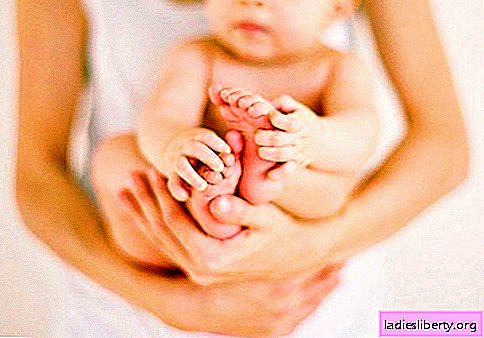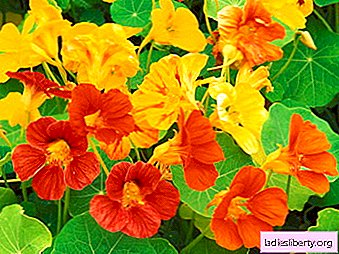
A popular plant in the circles of not only professional gardeners, but also among amateur housewives to decorate their window sills or front gardens at home is petunia.
Active and long-term flowering (from the summer until the severe frosts) and the richest color palette have provided a deserved popularity for this flower.
We will take a closer look at how to properly care for a petunia so that the process is fun and effective.
How to care for a petunia planted in a pot
Caring for a petunia, of course, depends on where the flower will be planted - on a flower bed or in a pot. Due to its unpretentiousness, petunia can easily decorate home balconies or windows.

If suddenly a petunia planted in a pot begins to be “naughty”, it is necessary to provide for the following possible problems:
• The selected pot is too small for the plant;
• The soil is lean;
• There is no drainage hole in the pot;
• There are fungal diseases in the soil;
• When planting a flower, the soil was incorrectly selected.
So that the work of growing and caring for a petunia does not become in vain, you should adhere to some rules before planting a petunia in a pot. You should start from the pot itself - it should be spacious, at least 3 liters of soil are required for one plant. The pot should have a drainage hole.
When planning the placement of pots or vases with petunias, it should be borne in mind that fresh air is mandatory for them. Plants without interference will tolerate temperatures up to 20 degrees. If large-flowered types of petunias are selected, then a higher air temperature is acceptable. The north side of the balcony or window will not allow the petunia to give abundant flowering. In addition, before rain, plants are best removed from open spaces.
Now it's time to take care of the right soil. Petunias prefer loose soil, so you can add a little washed sand to the finished soil (in the proportion of 1 part sand to 5 parts of soil). Instead of sand, you can use lime.
Fertilizers in the care of petunias need to play a separate role. You can use ready-made complexes that are sold in stores. Nitrogen-containing fertilizers must be added a couple of weeks after planting. At a later date, fertilizers with a high level of potassium and phosphorus must be used. To get a lush flowering of petunias, it is important to observe the frequency of feeding. During the period of active growth, “feed” the plant at least once a week.
Watering the petunias is necessary only under the root, preventing water from entering the leaves or flowers. Inadequate watering of petunia will be noted with yellowing leaves. Shriveled flowers and leaves must be peeled off - this will give the plant more strength for growth and flowering. If you want to give the petunia great bushiness and splendor - you need to pinch (mechanically remove) the tops in the region of 4-5 leaves.
Riot of colors on a flowerbed - how to care for a petunia planted in open ground
If seeds of plants are used to plant petunias in open ground, it is necessary to prepare them for "going out". For this, the seeds are planted in a box, which is covered with a film and put away in a warm place. After the first shoots, the box should be rearranged, but do not remove the film.

Sprouted sprouts are best watered from a spray bottle so as not to damage the fragile shoots. You can not pour water - from excess moisture, young petunias will die. As soon as the shoots get a few leaves, you can plant the plant in the ground. If May turned out to be warm, you can start landing, but it is better to do it on a non-hot or cloudy day. The distance between plants should not be less than 20 cm.
Before planting seedlings in the soil, it is important to fertilize the soil. It can be humus, compost, but in no case manure - it can provoke a disease of petunias. It is also recommended to add lime to the soil. Planted plants should be fed, but not as often and painstakingly as in the case of planting petunias in a pot. It will be enough for the "street" beauties once every 2 weeks to irrigate with mineral fertilizer, which contains potassium. Do not forget about weeding petunias and getting rid of weeds.
The first flowers will be shown by small-flowered varieties of petunias 2-2.5 months after transplantation. In varieties with large leaves, the result will be visible after 3 months. There are a number of recommendations that must be taken into account when planting petunias in open space:
• If any annual plants have already been planted on a flower bed or plot, you should not plant a petunia nearby - it can harm them;
• As with home planting, in an open area near a petunia, it is important to remove dried leaves, and especially flowers. Instead, seeds are formed in the petunia, which significantly absorb the forces of the whole plant;
• In order not to spoil the appearance of the entire flowerbed and not "drown out" the beauty of petunias, do not combine plants with simple flowers and terry varieties of petunias on the flowerbed;
• It is important to take into account that certain varieties of petunias have a pronounced smell - it is better to plant them on a separate flowerbed so that the fragrance does not interfere with the inhabitants of the house.
How to care for a petunia so that it does not hurt
Like any plant, petunia can be susceptible to certain diseases or negative environmental influences. The most common "troubles" that can occur with petunias are:
• Aphid. If petunia was attacked by aphids, it is necessary to treat the plant with special solutions for aphids, insecticides.
• Powdery mildew. If after a sharp temperature drop or prolonged humidity in the petunia a white coating appears, the plant is painfully mildew. It would not be a pity, but all areas of the petunia where plaque is detected must be removed. Then, the plant should be treated with sulfur.

• Root rot. This disease can be triggered by low air temperature (below 14 degrees C), a long period of high humidity, an excess of fertilizers with nitrogen. The disease manifests itself as follows: the stems, flowers and leaves of the petunia begin to become covered with brown spots, and then a gray fluffy coating appears. During the period of illness, it is necessary to limit watering, carry out treatment with fungicides, and remove the affected areas.
What to do to take care of petunia less?
It is not difficult to guess that the seed is the basis of any plant. It is the seeds that determine the beauty and vitality of the future petunia. Its seeds are of two types - coated or clean. It is better to give preference to those that are coated, as it will provide seeds with additional protection against mechanical damage and disease. In addition, seeds with a shell are larger in size, which facilitates their sowing. There is only one drawback of such seeds - they are more expensive.
It is impossible to determine which particular petunias should be grown on the balcony or in the garden. Due to the variety of varieties and types of petunias, one can easily lose one's head. Someone will like ampelous (“creeping”) petunias, for some, bushy ones will be the best option, and someone will give their heart to many-flowered ones. It does not matter in which grade the choice will be made. Due to the unpretentiousness of plants, everyone will be able to properly care for the petunia in order to get a breathtaking garden or a balcony.












